Technical analysis of ancient peruvian ceramic vessels
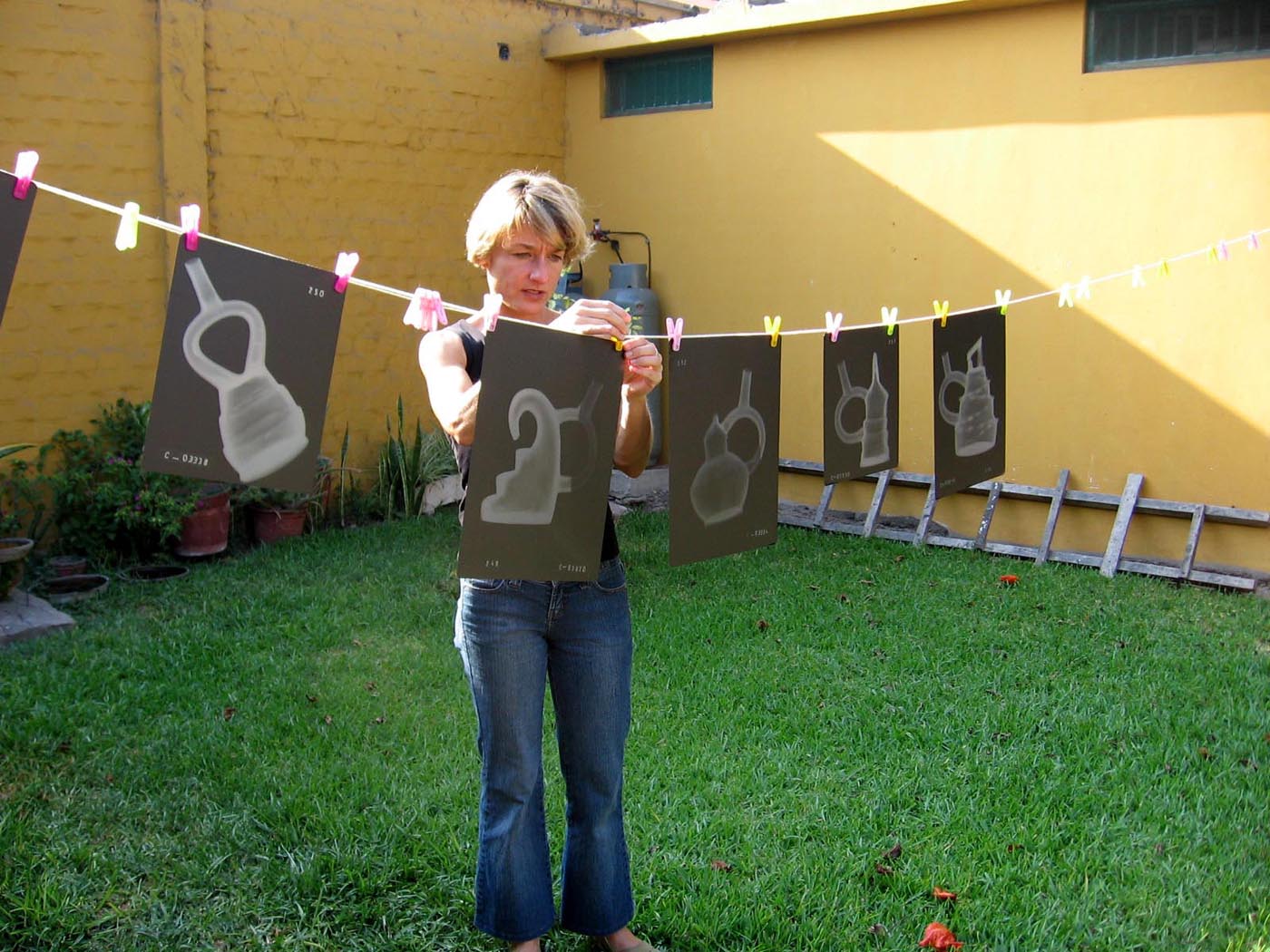
In the inner courtyard of the Museo Nacional de Antropologia, Arqueologia, e Historia, Lima, Peru
x-ray analysis of ceramic vessles from Peru's north coast
With conservators and technicians at the Smithsonian’s National Museum of the American Indian and the Museo Nacional de Antropología, Arqueología, e Historia in Lima, Peru, I have conducted technical analysis of ancient ceramic vessels using radiography and xero-radiography. These studies have shed light on the way vessels were constructed by ancient artists.


Developing the x-ray plates
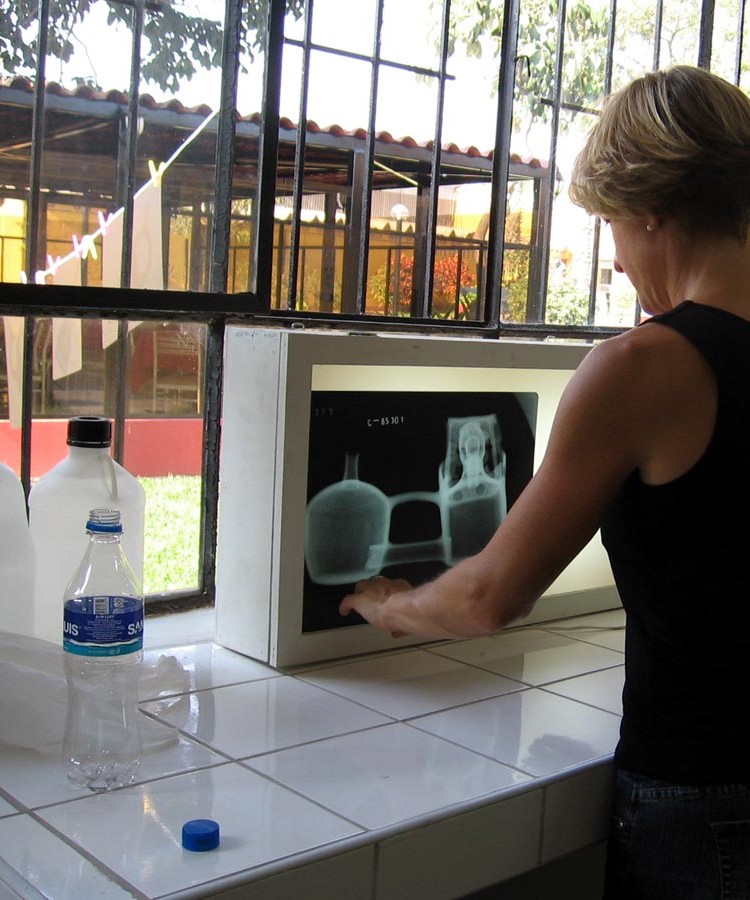
Studying x-ray plates using a light box
technical details
A Hitex type HX-150 machine was used to x-ray the ceramic objects under investigation. The machine range was 0-150 kv; 120-125 kv was the range for the ceramic objects examined.
The machine was specifically calibrated for each individual piece and x-rayed, based on the weight of the object.
For each x-ray, three measurements were recorded:
(1) Kv = voltaje; the quantity of radiation that penetrates a piece
(2) MA = amperaje; related to the weight of piece. For objects x-rayed in this study, it varied between 1.9 and 2.8. The machine automatically shuts off if MA reaches 3.0
(3) Time = number of seconds each piece was penetrated by x-rays. For this study it ranged from between 40 and 54 seconds. Generally, the less the kv, the more time that is needed. The weight of pieces in the study ranged between and 400.6 gr and 1.555.3 gr.
All measurements were recorded and are held in the MNAAHP Department of Ceramics.
Plates were developed in the darkroom on the premises of the MNAAHP by Wilfredo Cordero and Carlos Murga. Plates were dried on a clothesline outside the Department of Metals (see photo above) and analyzed with the aid of a light box.
X-ray plates are housed in archives of the Department of Ceramics at the MNAAHP.
Plate numbers start at 215 and end at 252.
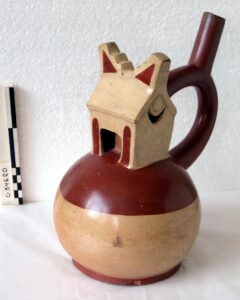
Vessels studied
This is an example of an architectural whistling vessel with a resonating chamber.
The whistling mechanism sits inside the architectural structure and sound resonates within it before escaping through “door” and crescent shaped “windows.”
MNAA C-54620

In the x-ray of the same vessel, we can better see the whistling mechanism inside the architectural superstructure.
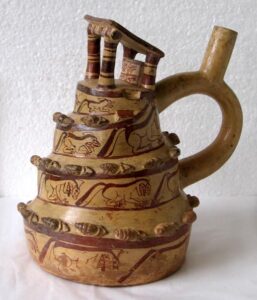
This is not a whistling vessel but its spiral chamber was so compelling, we could not resist x-raying it to see what it might look like structurally.
MNAA C-03340
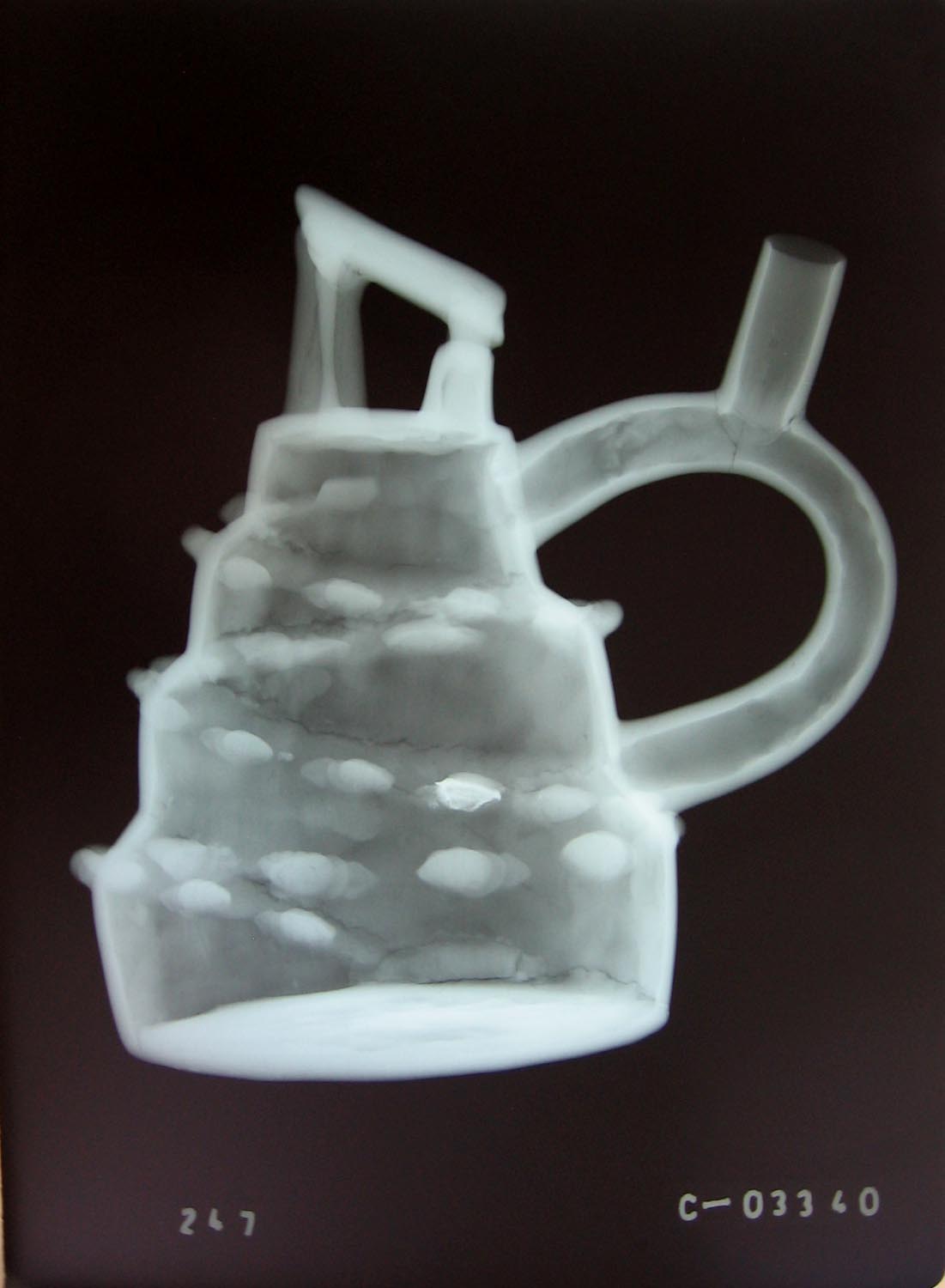
In this image, the sculpted snails which help define the spiral are seen as solid (white) forms.

This is another spiral chamber with an architectural superstructure. While thematically, it is similar to the vessel above, stylistically and morphologically it is quite distinct. The fineline illustrations around the chamber depict felines, whereas in the vessel seen above, foxes are depicted.
Metropolitan Museum of Art 63.226.13
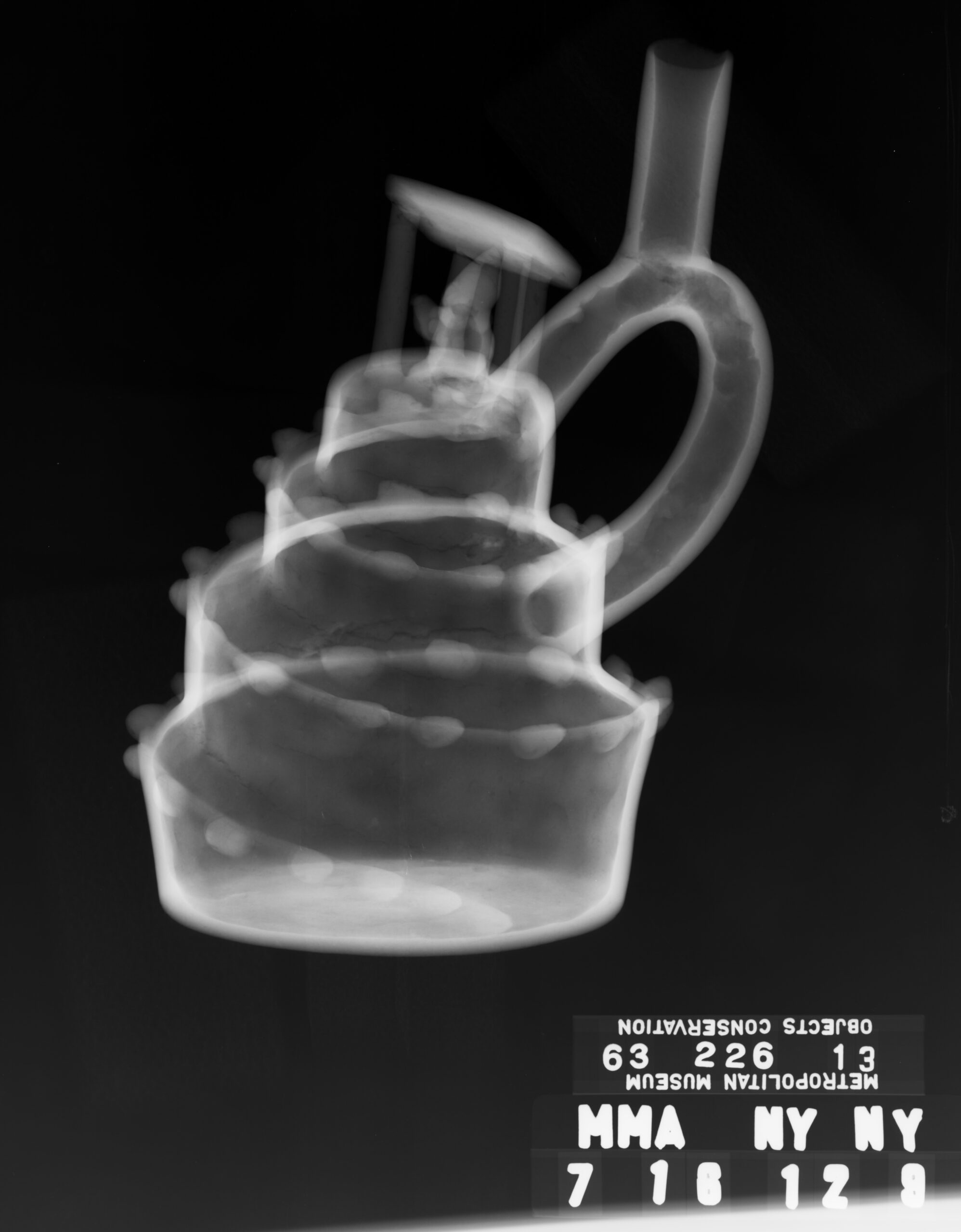
Metropolitan Museum of Art 63.226.13

This Vicus double chambered architectural vessel may not look impressive in this image, but the x-ray below helps to illuminate that it had a complex construction process.
MNAA C-65301

The connecting tube at bottom is hollow, allowing air from the chamber at right to flow into the chamber at left, entering into the whistling mechanism and reverberating within the sculpted hollow head.
MNAA C-65301
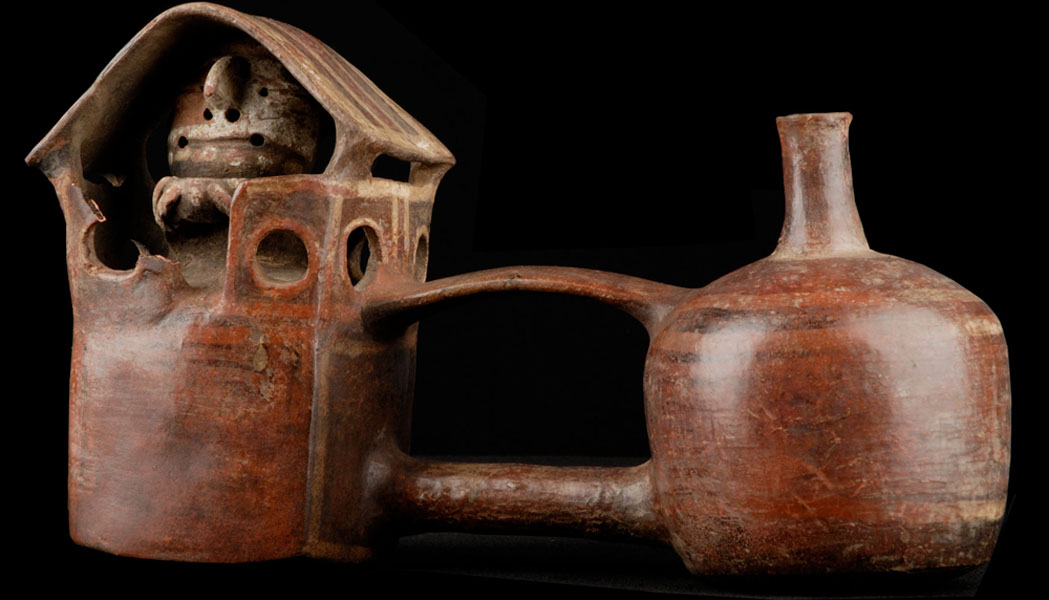
At the National Museum of the American Indian is another Vicus double chambered architectural whistling vessel, 243523.
What is special about these vessels is that sound can be produced by blowing into the spout, but it can also be produced by pouring water into the vessel. Water, once in the chamber, moves through the hollow bottom tube pushing air into and through the whistling mechanism, producing sound.
To hear what these vessels sound like, visit the section on acoustical analysis.
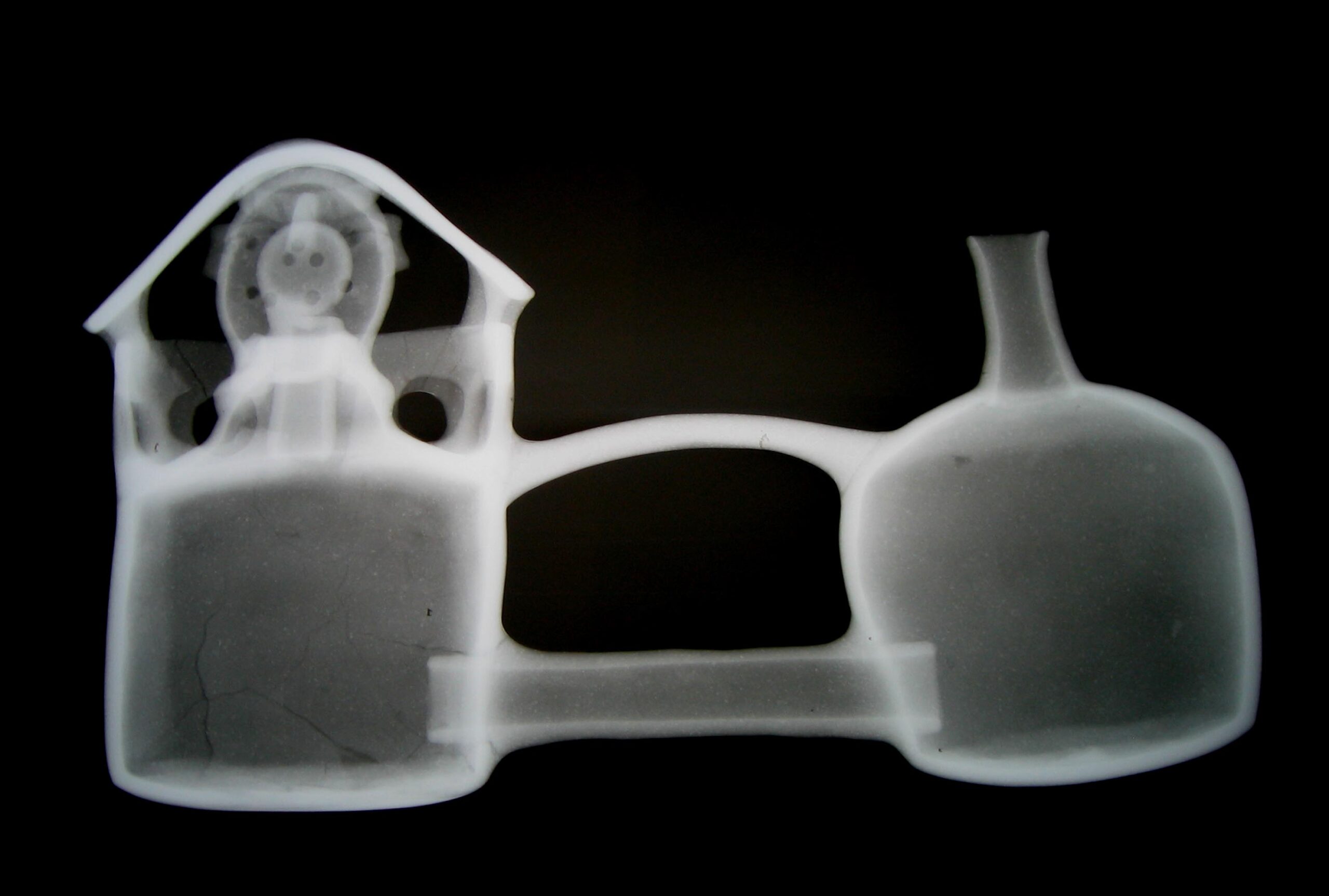
In this x-ray of the same vessel, we see that the connecting tube at bottom is hollow, allowing air from the chamber at right to flow into the chamber at left, entering into the whistling mechanism and reverberating within the sculpted hollow head of the figure within the architectural structure.

This vessel and the one below it reveal a technological style very similar to the Vicus vessel, where a hollow tube below connects both chambers and allows for air to flow from the back chamber (at right) to the front chamber at left).
MNAA C-54417
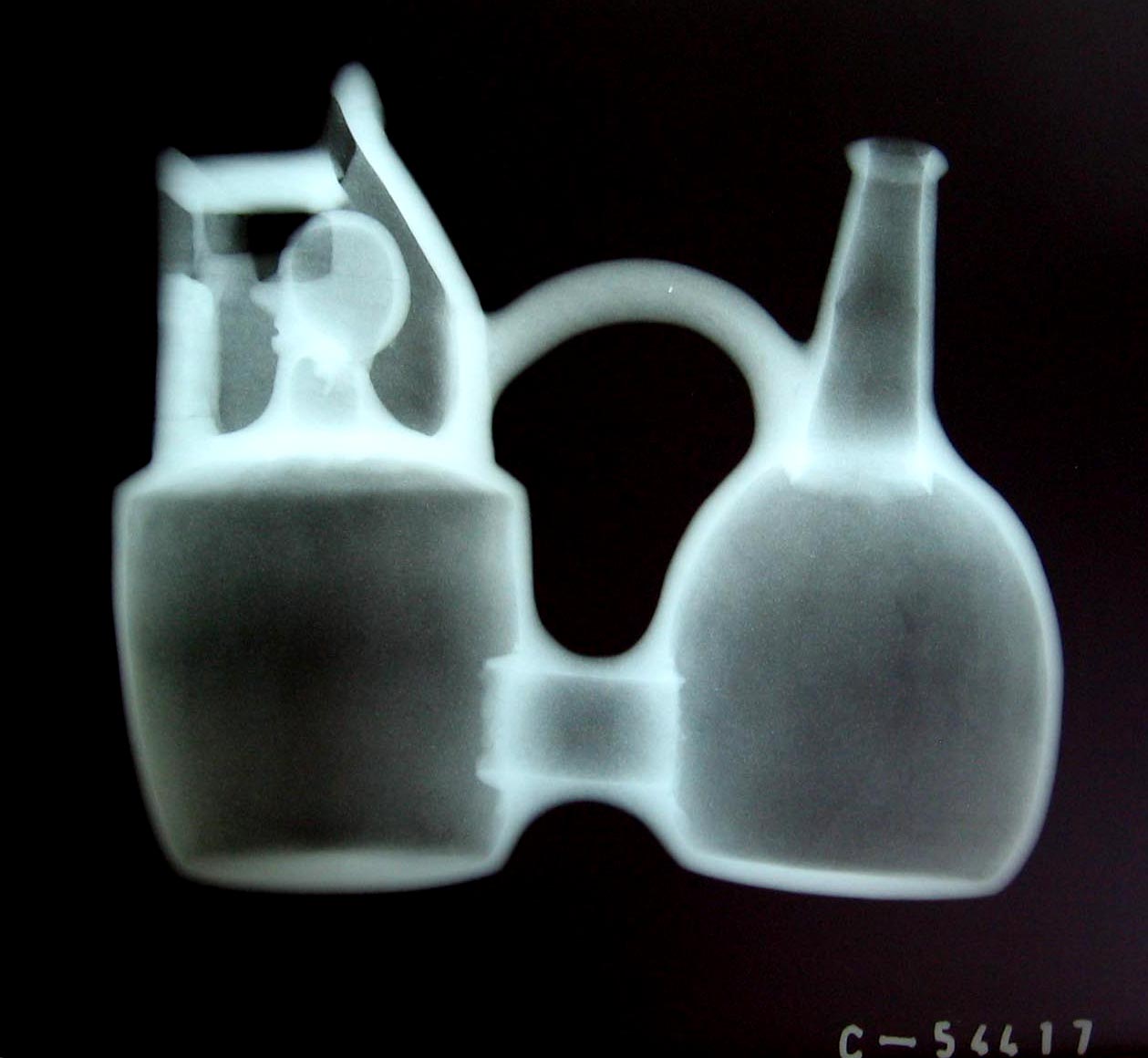
Here again, the x-ray allows us to see the whistling mechanism which has been given facial features like a nose!
MNAA C-54417
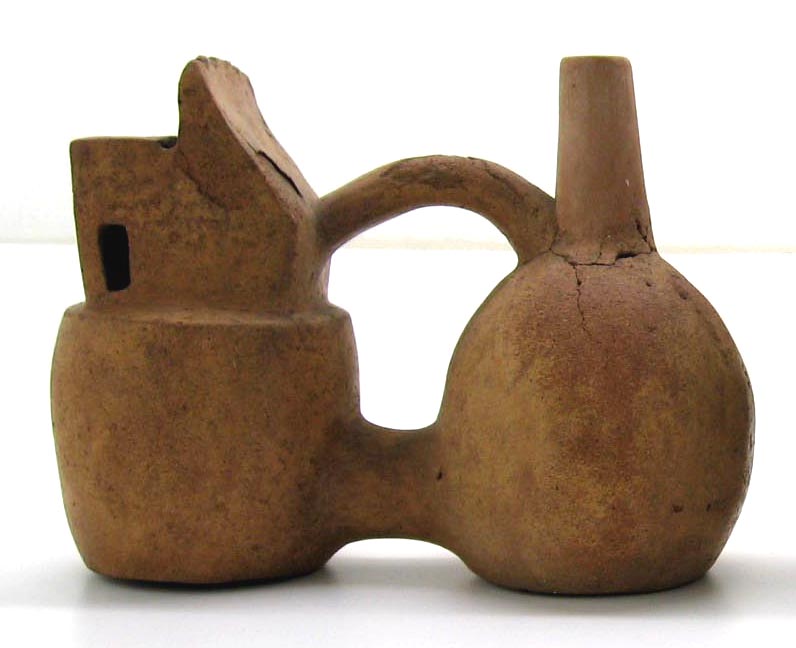
Externally, this vessel looks very distinct from the black ware vessel above, which is highly burnished and has a lip around the spout.
MNAA C-65326
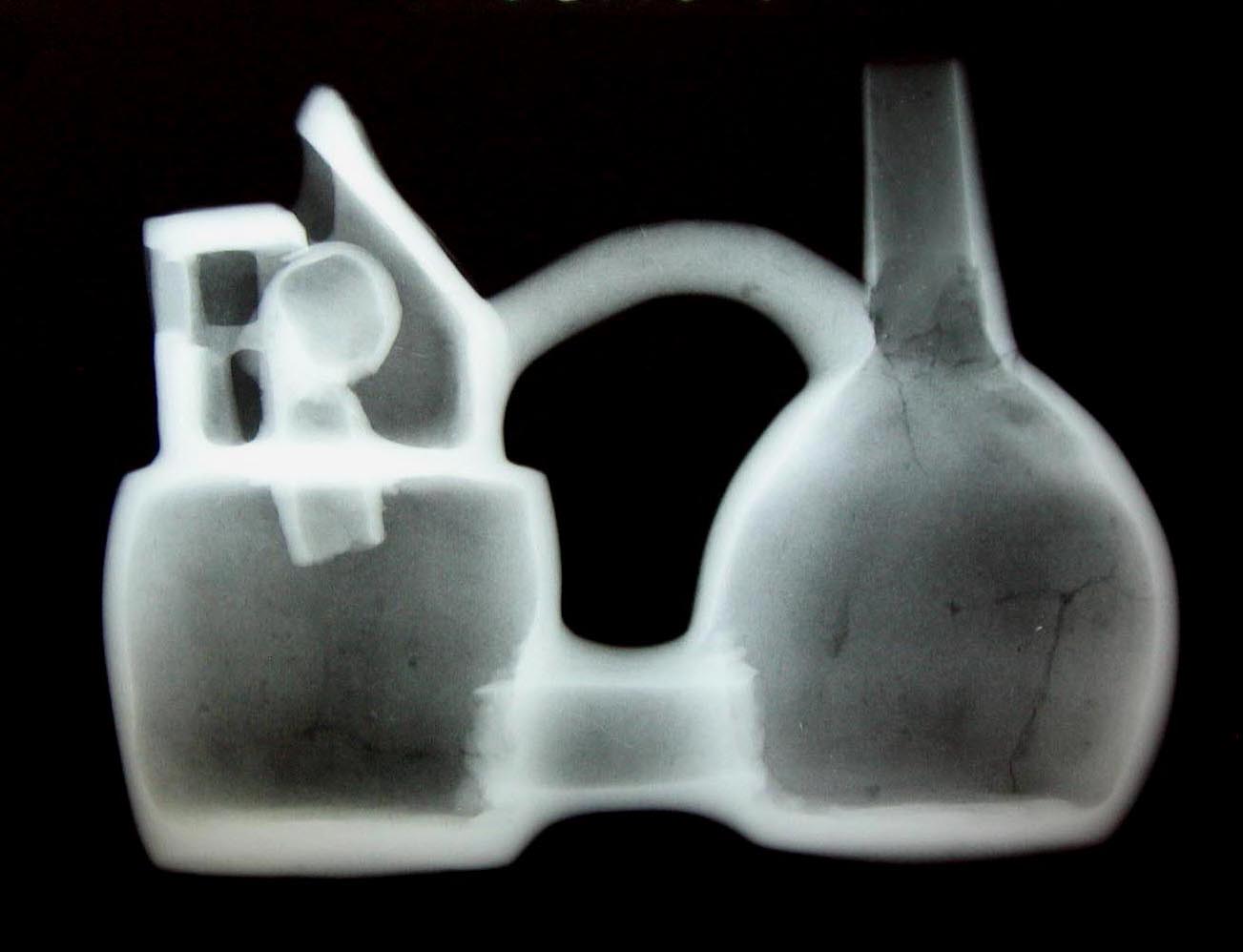
However, if we compare the x-rays of both vessels, we see construction similarities including the morphology of front and back chambers, the solid handle, the hollow connector tube, and the nose that the whistling mechanism “wears.”
MNAA C-65326
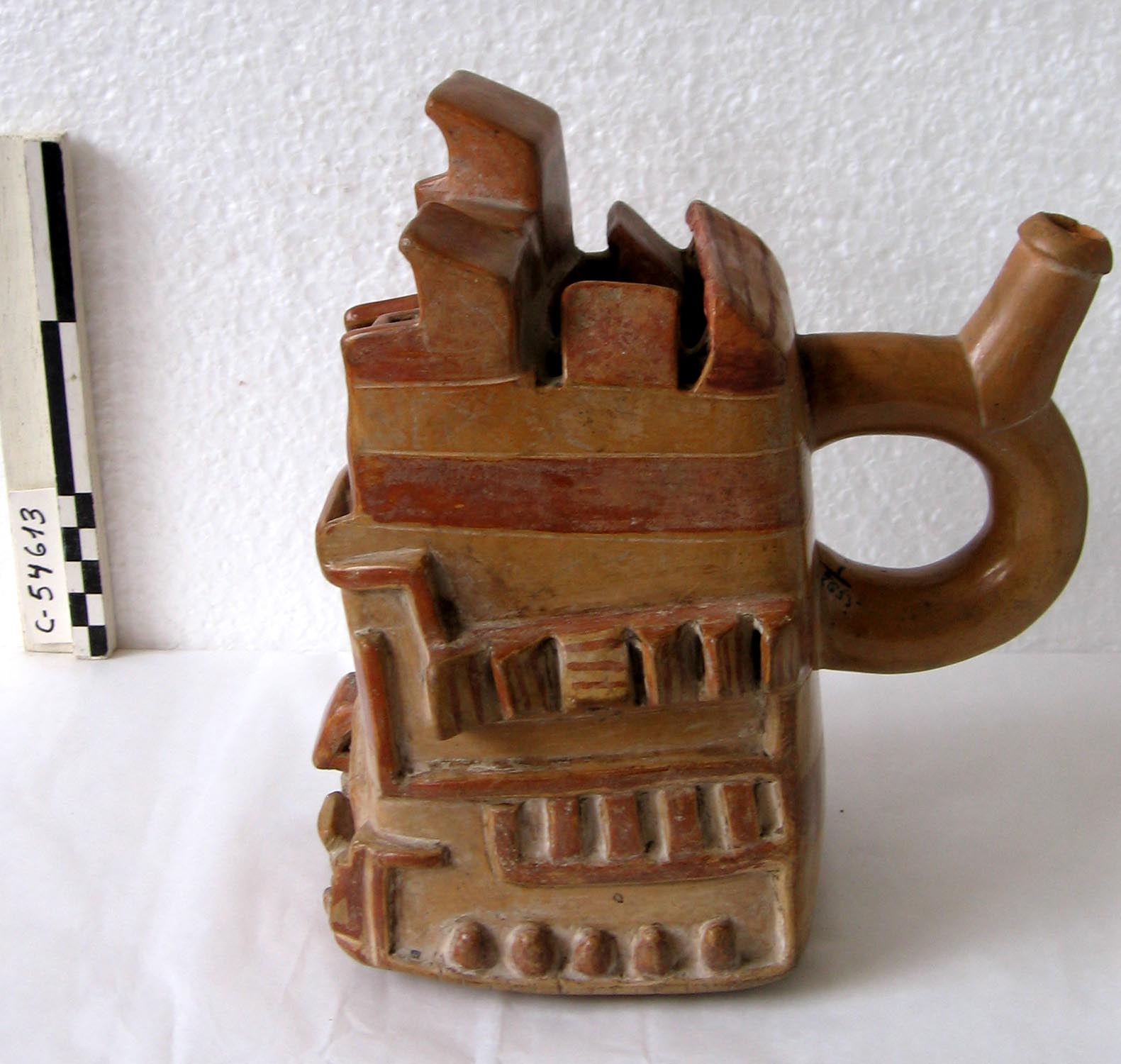
This vessel, one of the most “famous” of all the Moche architectural vessels is not a whistling vessel. But, we were still curious about its construction methods, so we went ahead and x-rayed it.
MNAA C-54613
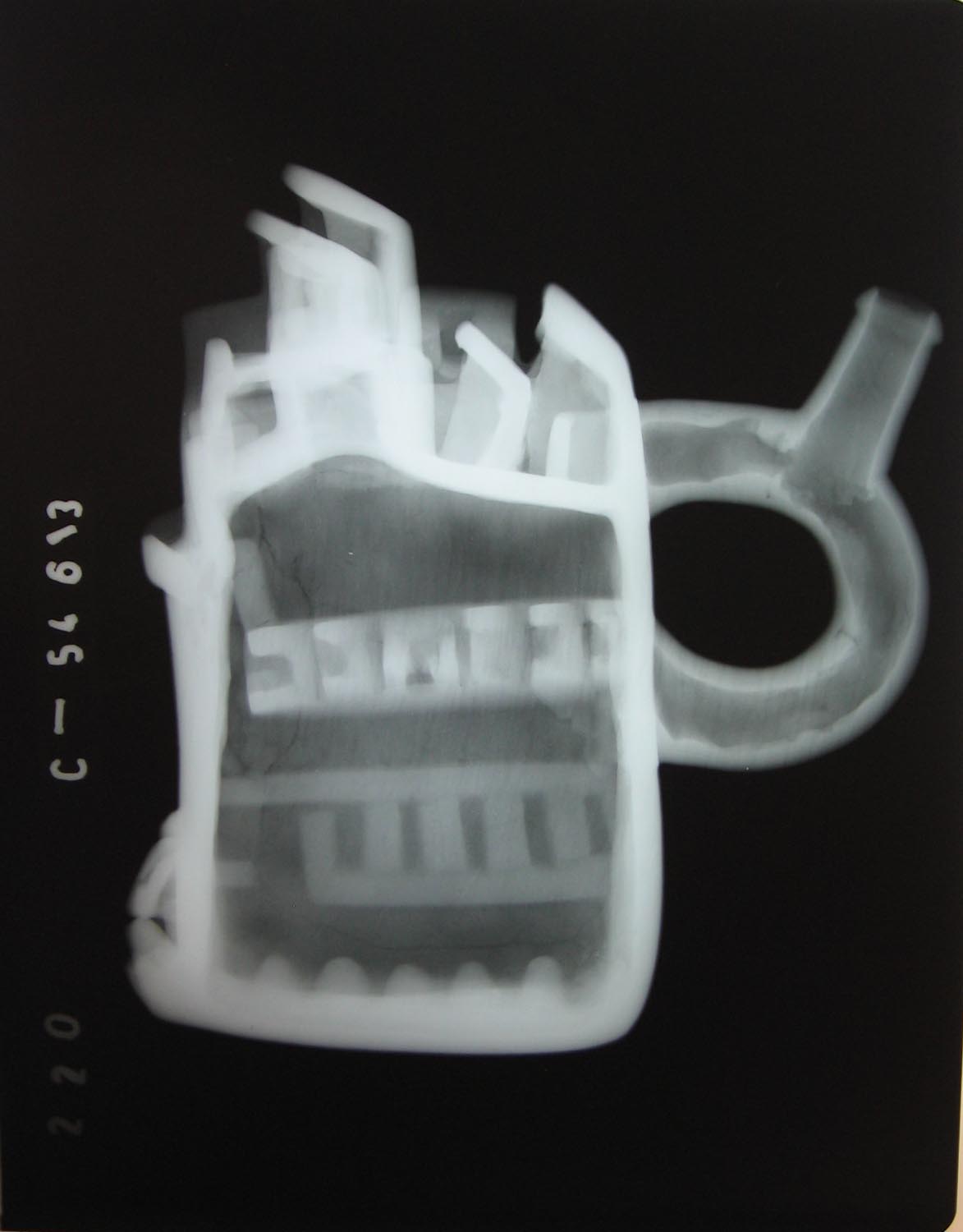
MNAA C-54613
Technical analysis, Xero-radiography
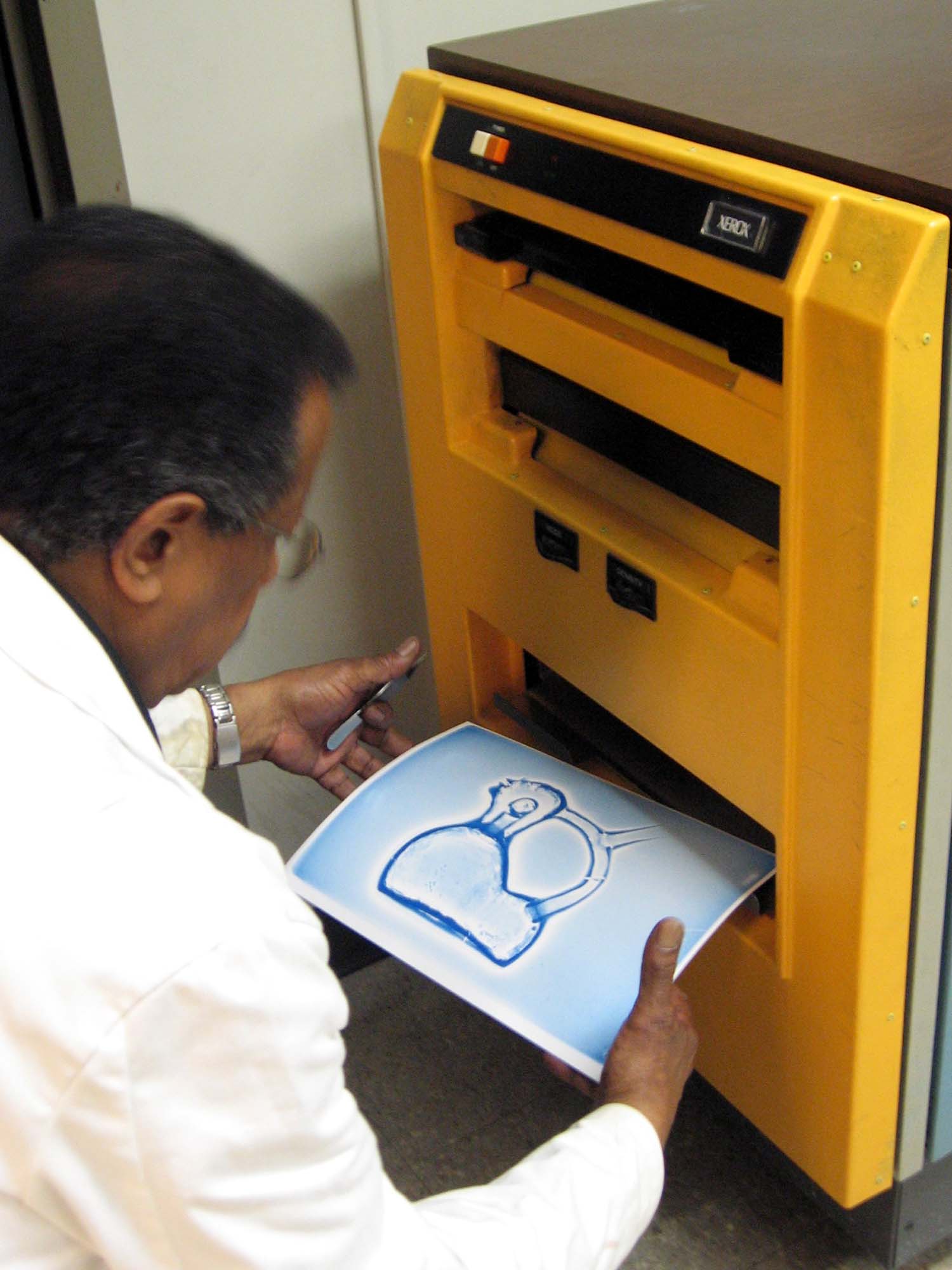

Xero-Radiography of north coast Peruvian vessels
While a fellow at the Smithsonian’s National Museum of the American Indian (NMAI), I had a unique opportunity to use xeroradiography, as well as radiography, to study a sample of ancient ceramic vessels from Peru’s north coast.
Xeroradiographic images provide even more detail and visual information than their radiographic counterparts. Images provide clearer definition of vessel components and even ancient finger impressions.
Xeroradiography is a type of X-ray imaging where a picture of an object is recorded on paper rather than on film. This process was developed by engineer Dr. Robert C. McMaster in 1950.
NMAI is one of few museums to have this type of equipment.
I am grateful to Ron Cunningham at MCI who calibrated machines and took x-rays and xero-radiographs of the vessels studied. Digital photographs of the ceramic vessels were taken by Emily Kaplan and digital images of the x-ray plates were taken by Ernest Amoroso.
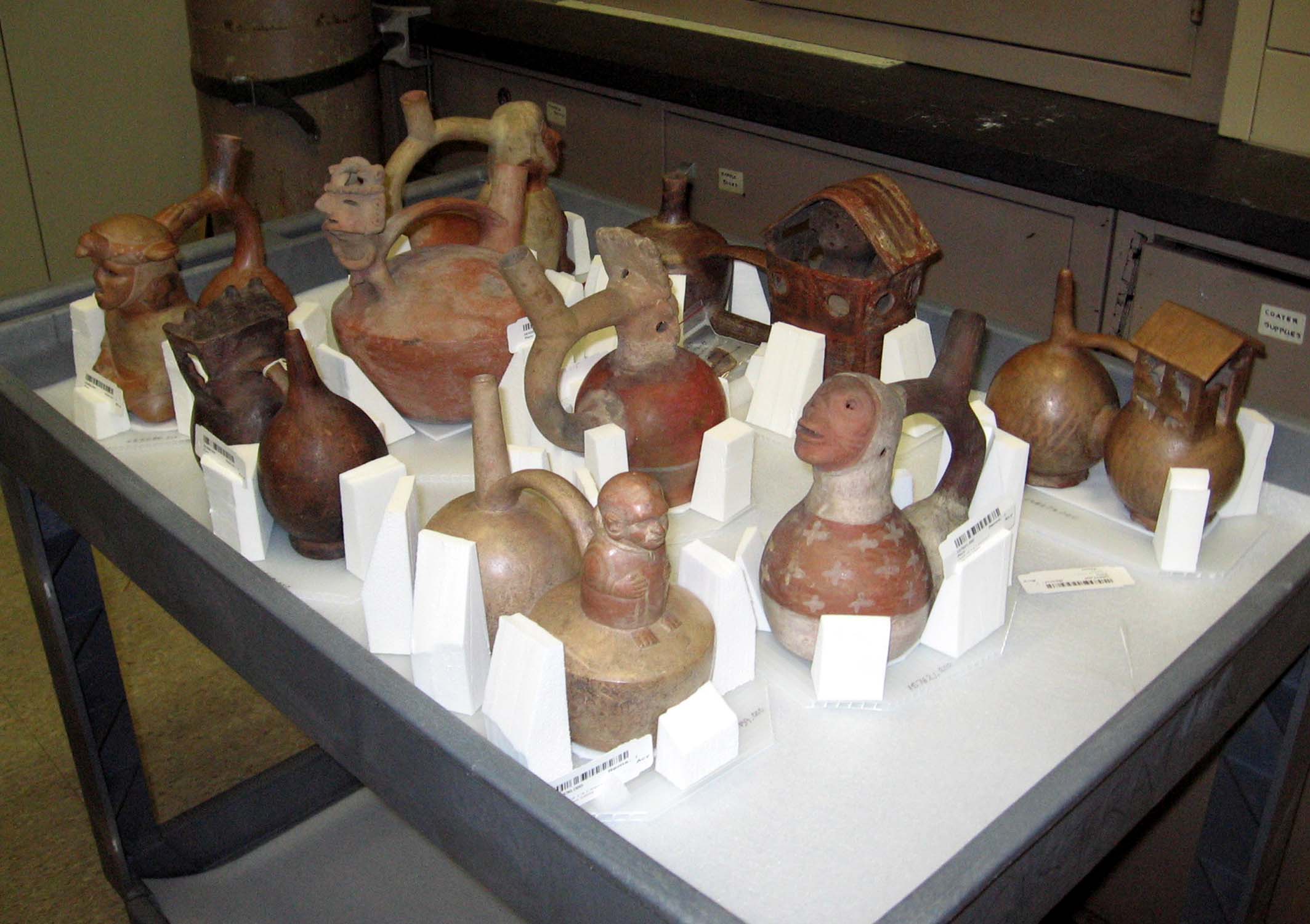
Vessels to be x-rayed were pulled from storage and placed on a cart.
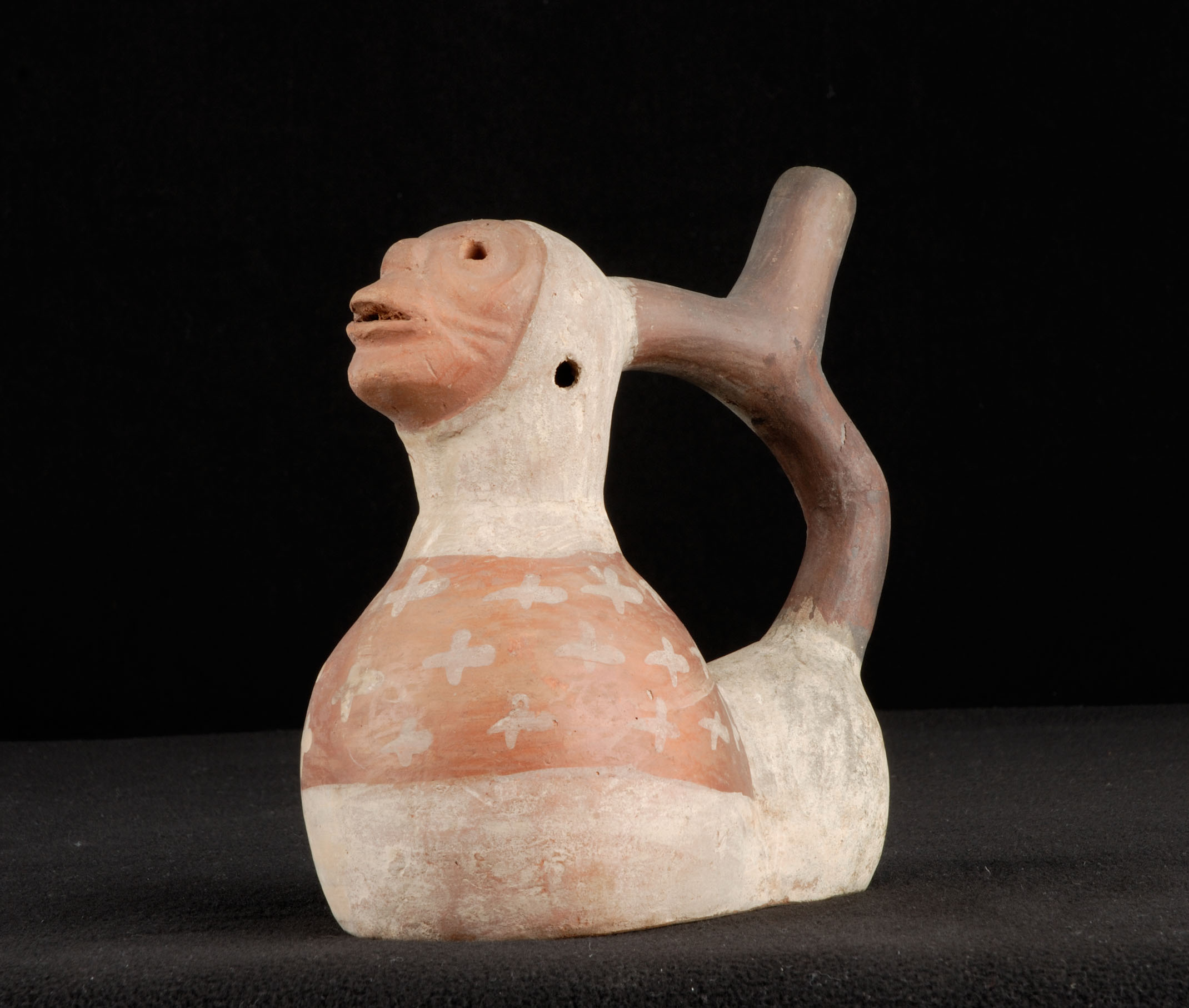
This double-chambered Moche V whistling vessel with stirrup spout has a back chamber that is smaller than the front. Both adjoin directly rather than being connected by a tube, as is further visible in x-rays and xero-radiographs. Within the head is a whistling mechanism. Holes allow resonant sound to escape.
This vessel plays one primary note which is rather shrill and rises in pitch as more air is introduced.
Note(s): F sharp +40 cents, 440 hertz; G +20 cents, 440 hertz; G sharp +40 cents, 440 hertz
NMAI 157621
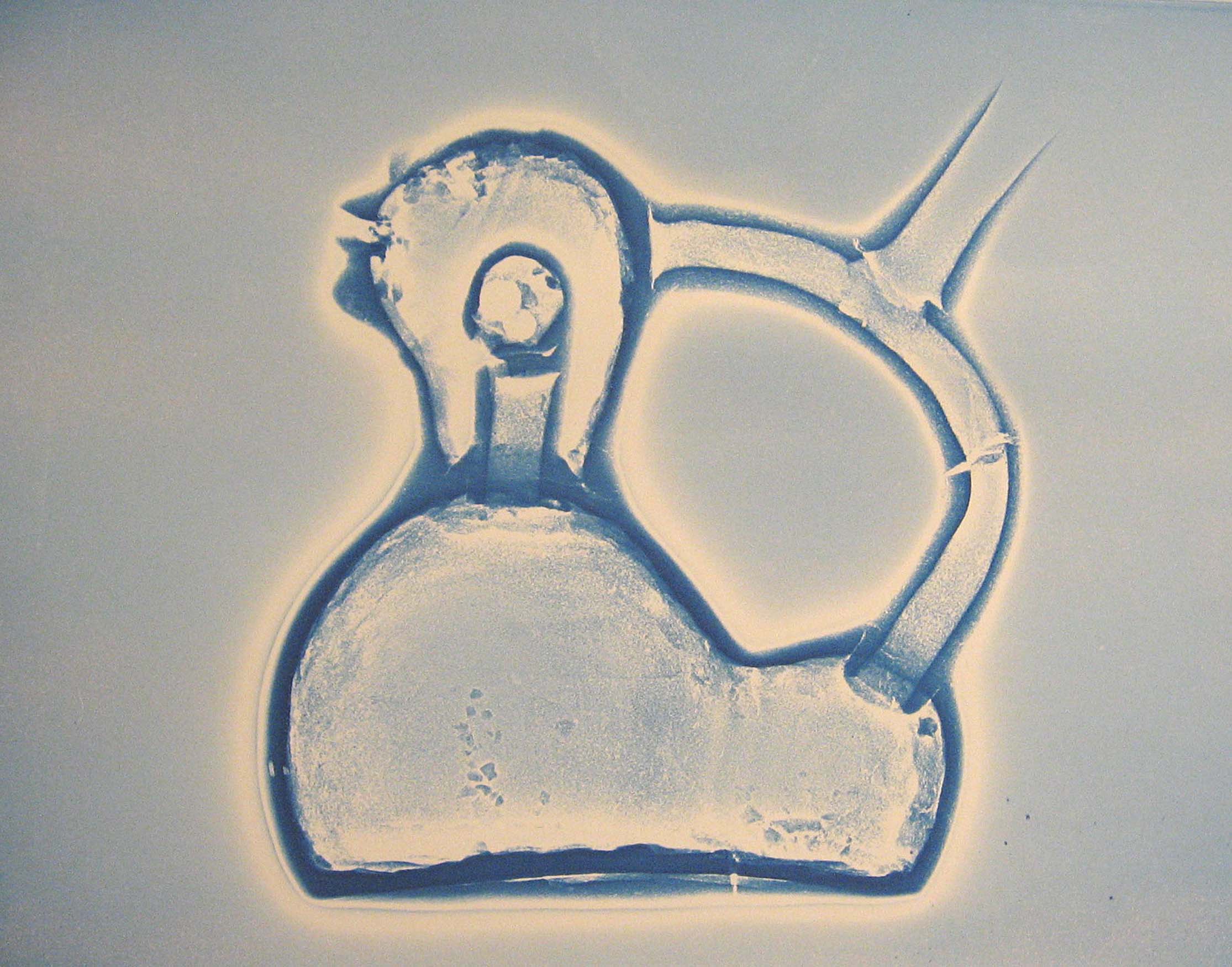
This xero-radiograph provides detailed visual information about the hollow handle’s insertion into the back chamber of the vessel. Air, introduced into the spout, would move through the chamber up into the whistling mechanism and exit as sound which would resonate in the head (or resonating chamber) of the vessel and exit through holes seen in the photo above.

This x-ray of the same vessel reveals how much more detail is evident in the radiograph.
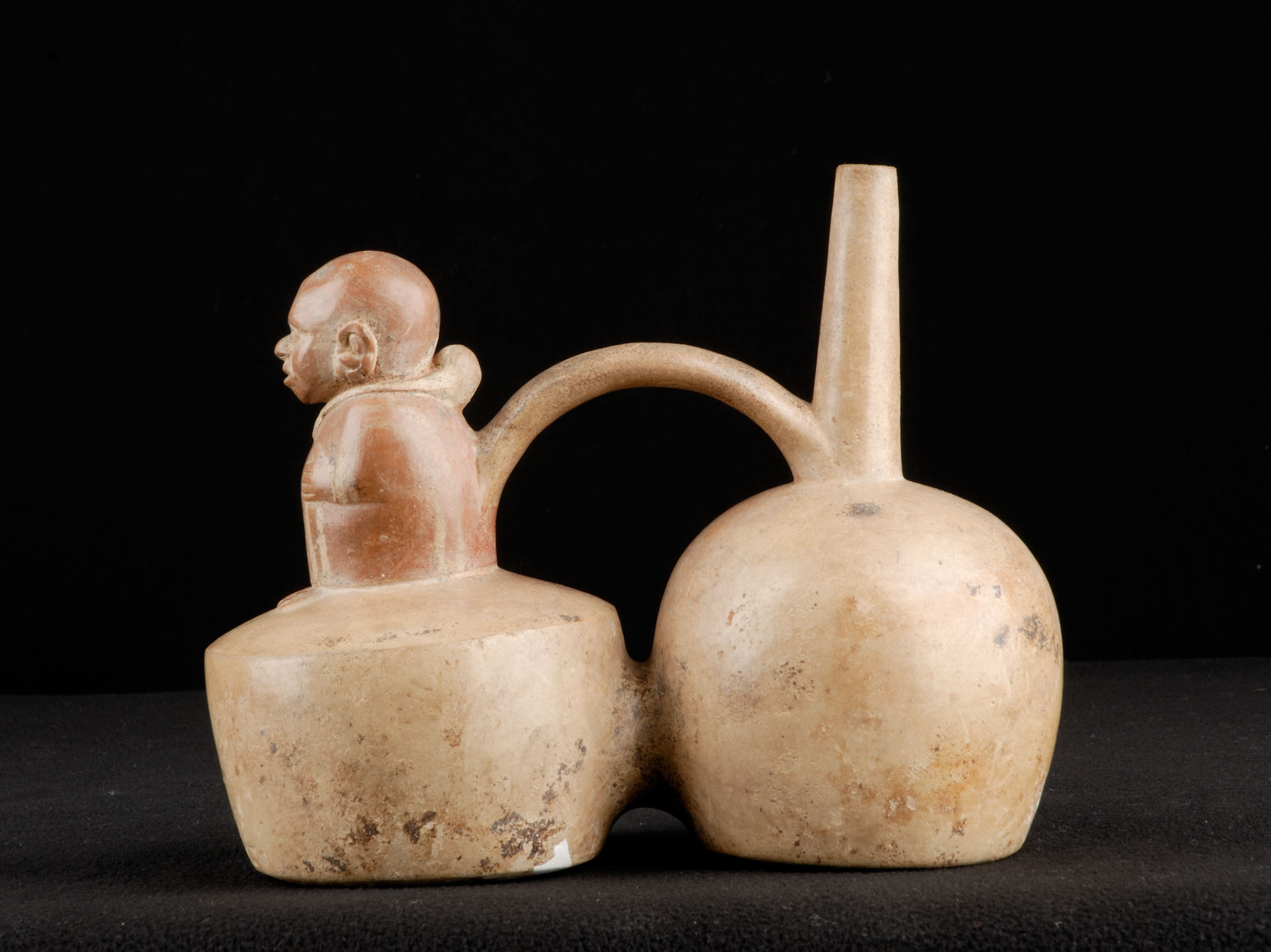
This is a double-chambered Early Moche whistling vessel. The spout and bridge connects to the back of a seated figure with bald head whose knees are bent to the chest, hands resting on his knees. Around the figure’s neck is a scarf (?) which is bulky at the back. Within this, the external whistle is housed. Its small size results in a high pitched note.
Note(s): G sharp – 30 cents, 440 hertz
NMAI 238959
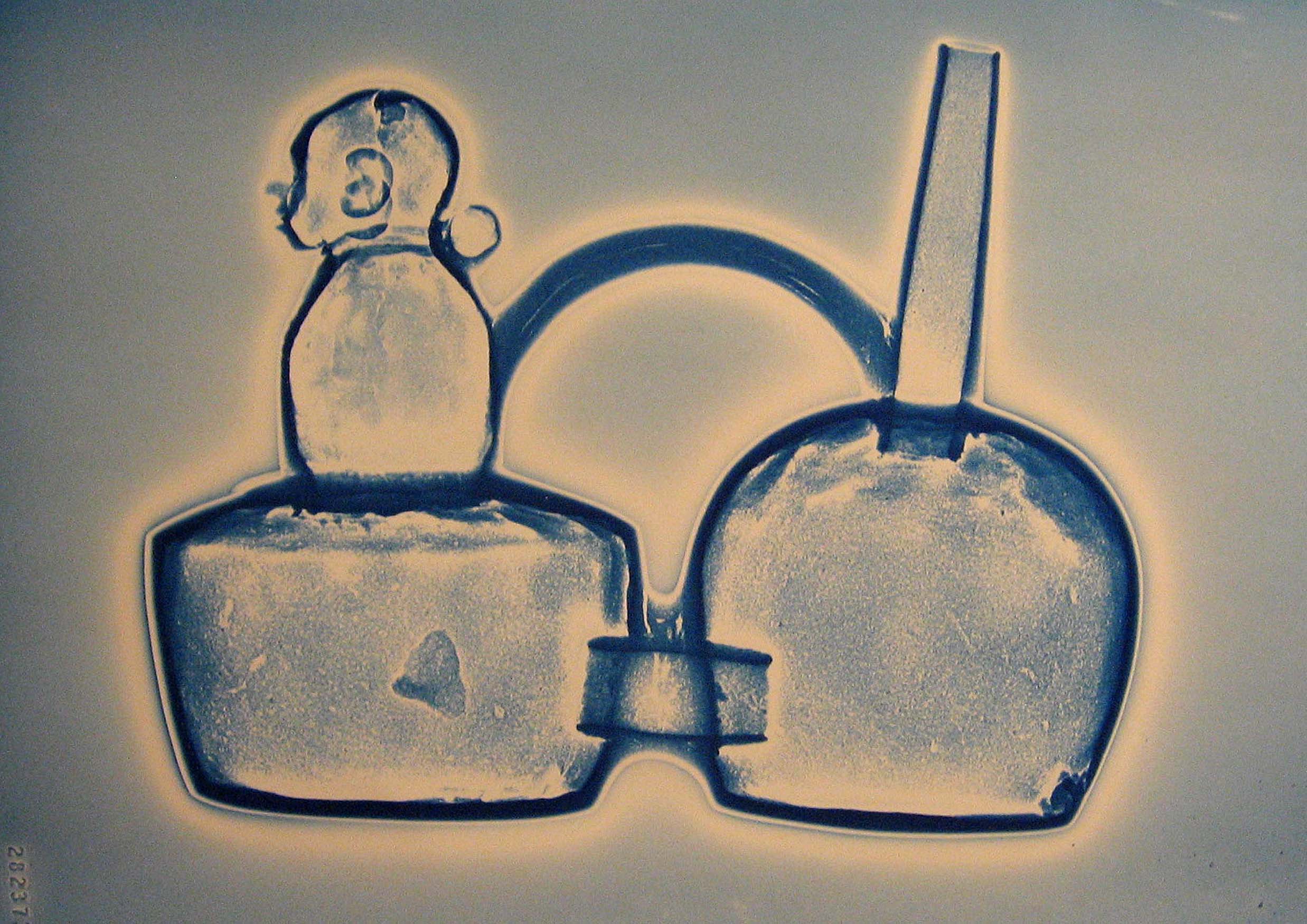
In the xero-radiograph, the connector tube is visible. What appear to be finger impressions can be seen on the inside top of front and back chambers.
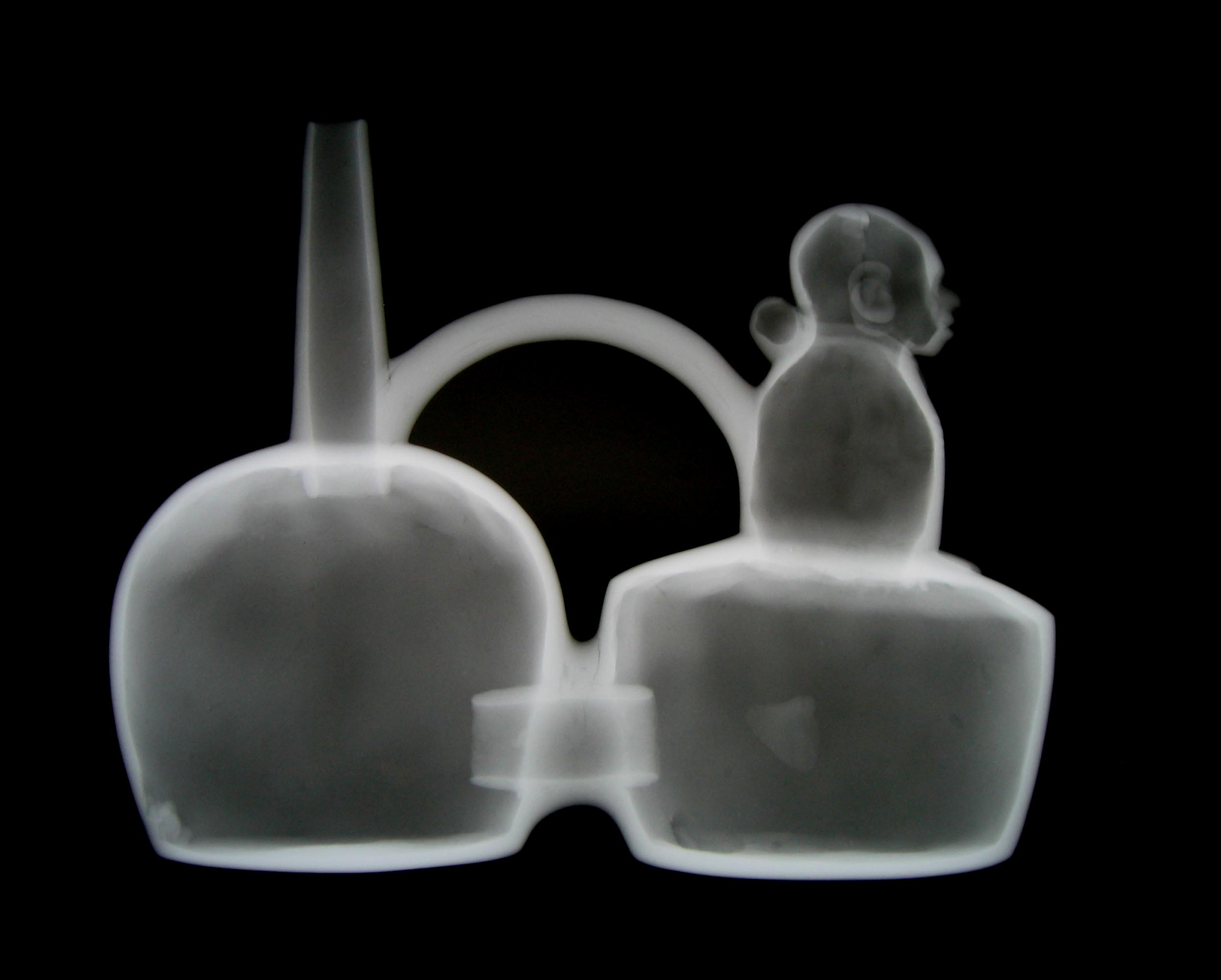
In the x-ray, the connector tube is visible but what is less evident are finger impressions from the artist.

In this double-chambered Vicus whistling vessel, front and back chambers are connected by a long tube and a solid bridge or handle. The back chamber has a short spout, which inserts into the back chamber, while the front chamber supports an open gabled roof structure. Inside, the head of a figure is housed. Five perforations at the back of the figure’s head, in addition to perforations under the nose and at the corners of the mouth, permit the exit of two primary notes, which are fixed, strong, and clear.
Note(s): C sharp +20 cents, 440 hertz; C +30 cents, 440 hertz; G +20 cents, 440 hertz; G 0 cents, 440 hertz; G -20 cents, 440 hertz
NMAI 243523
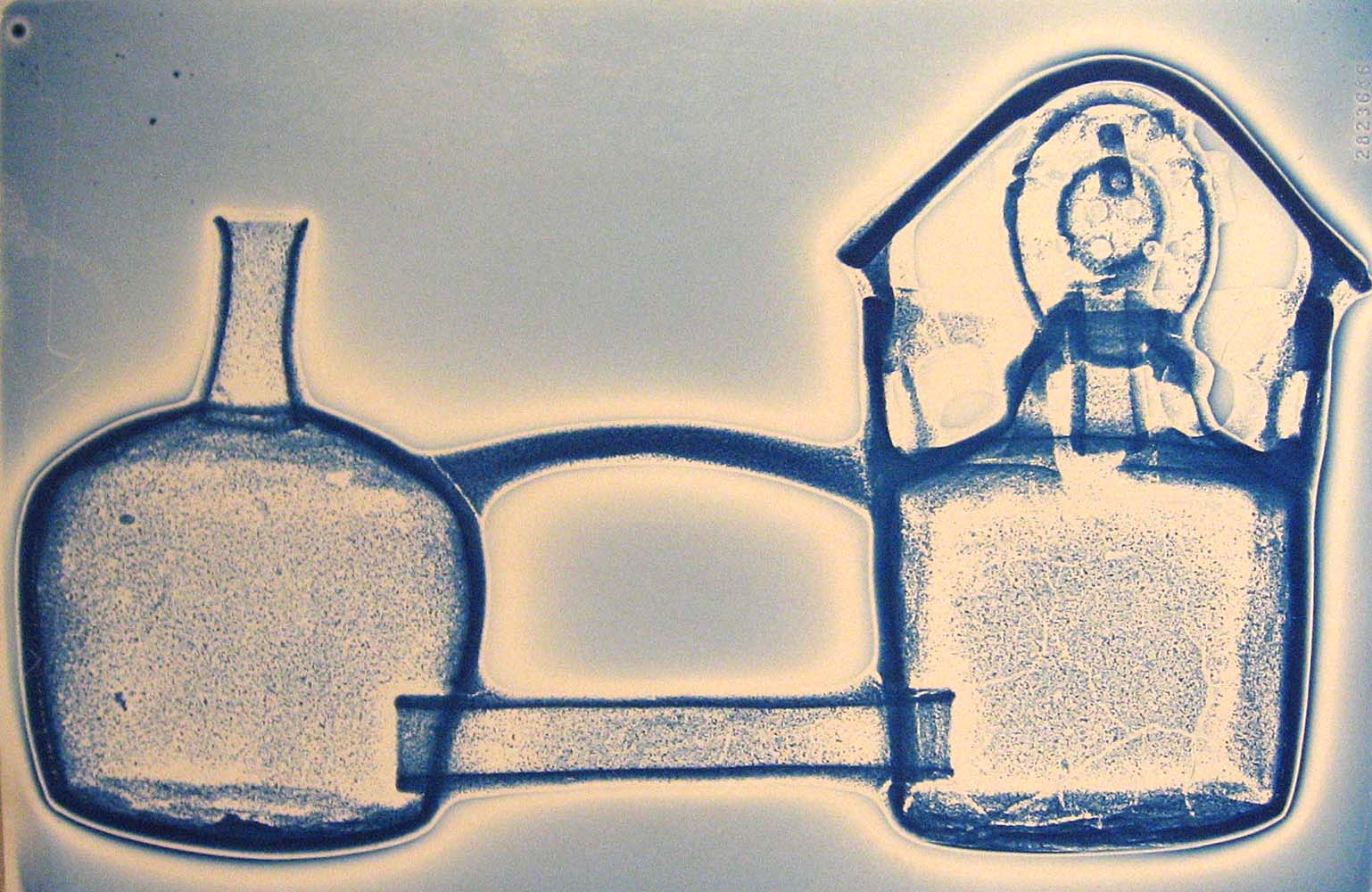
The whistling mechanism inside the figure’s head is clearly defined in the xero-radiograph, as is the hollow connecting tube uniting front and back chamber.
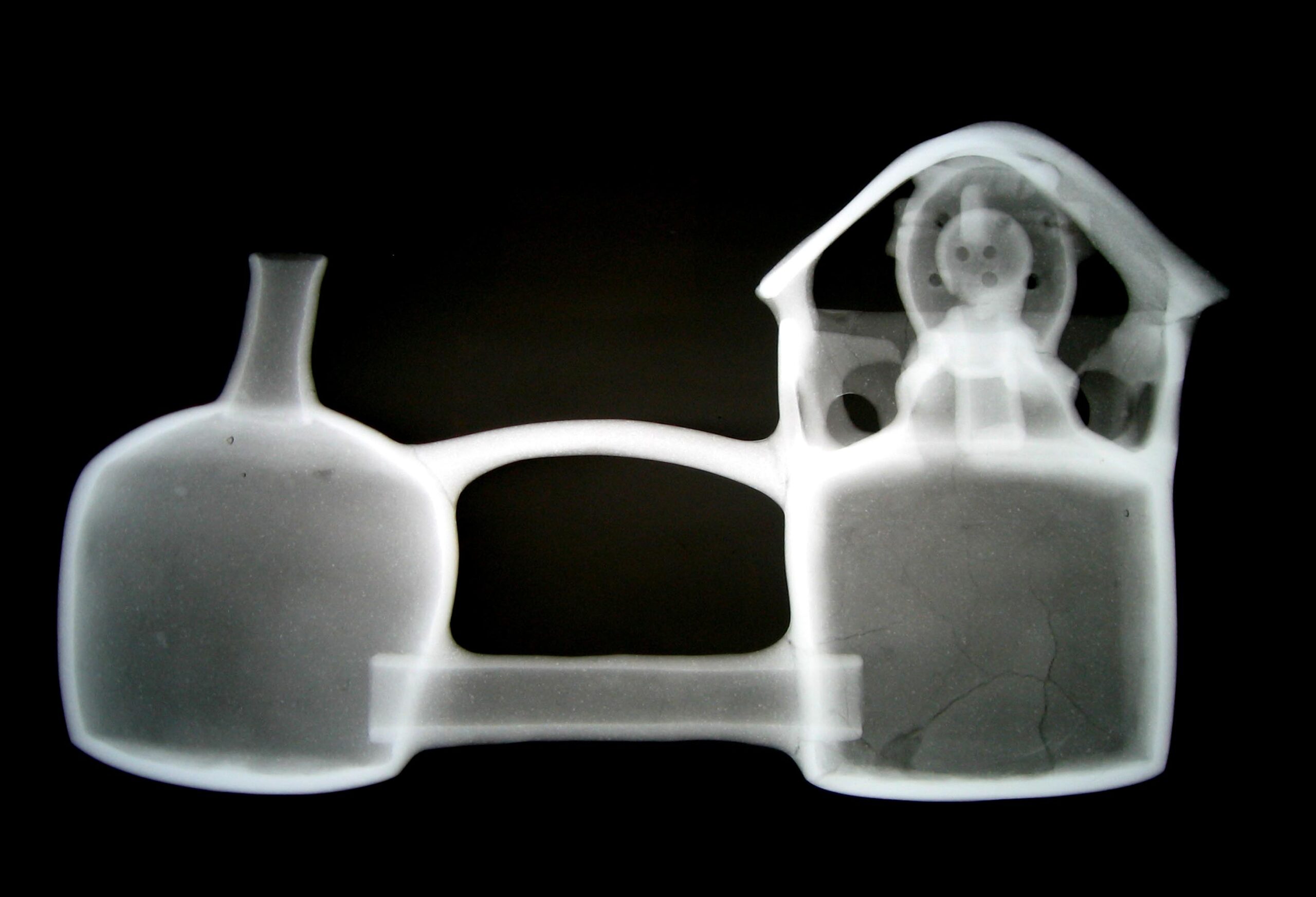
The x-ray of the same vessel is illustrative but less so than the xero-radiograph.

In this double-chambered Moche III whistling vessel in the form of a parrot, front and back chambers are connected by a “tube” and a solid bridge handle. The front chamber is larger than the back chamber. Two holes at the back of the head and two on the beak, in addition to openings on each side of the beak, allow sound to escape from the whistling mechanism within the parrot’s head. Two to three notes are possible, depending on the amount of air entering whistling mechanism, but, as with other vessels, less air produces a lower note, while more air produces a more piercing sound.
Note (s): E 0 cents, 440 hertz; E -30/-490 cents, 440 hertz; B +40 cents, 440 hertz; E flat +40 cents, 440 hertz
A088263-0
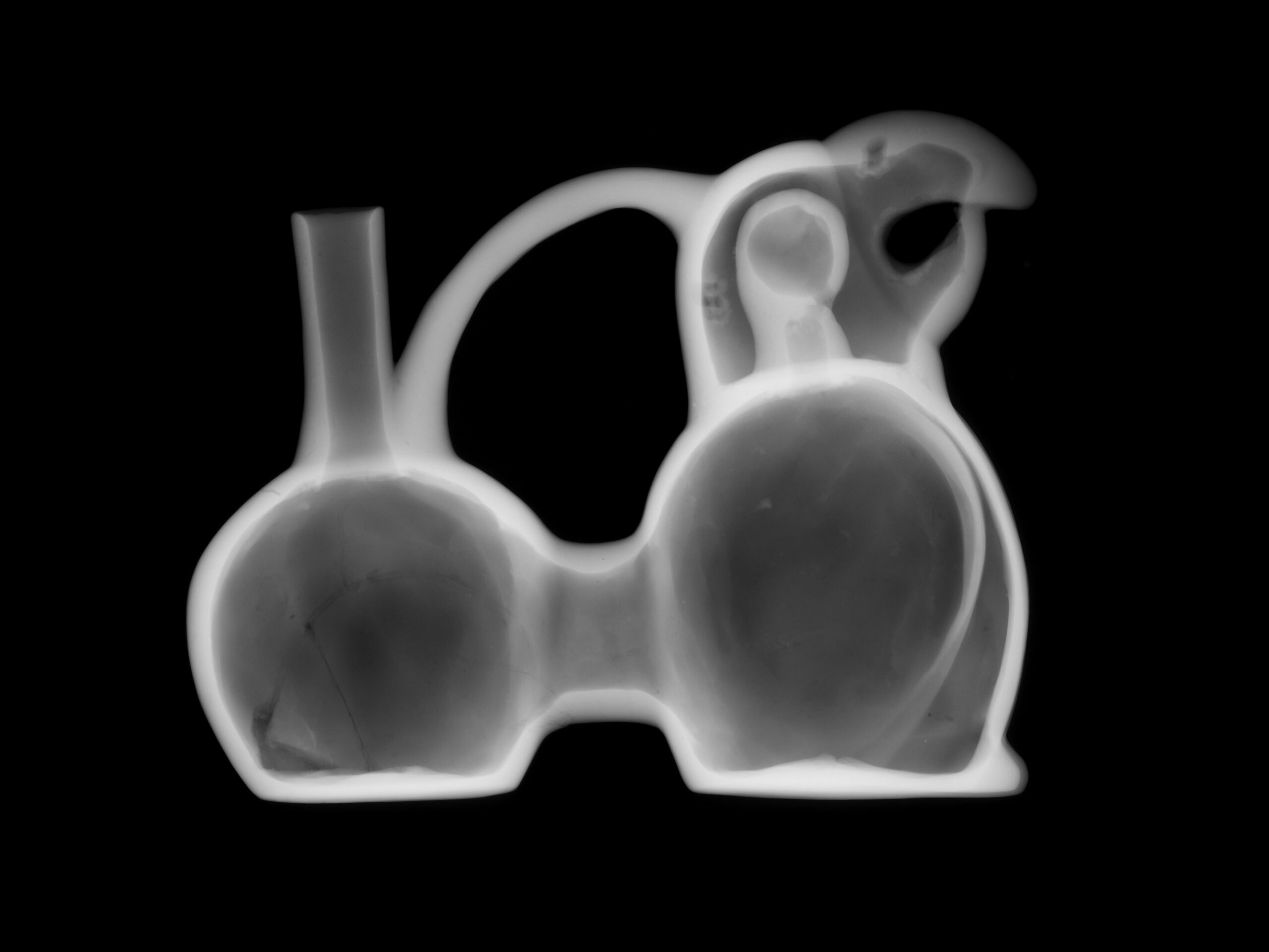
In the x-ray, the whistling mechanism is visible and we see a more seamless integration of the tube that connects front and back chamber.
No xero-radiograph was taken of this vessel.
Technical analysis, X-rays

X-ray plates hanging to dry in one of the museum’s inner courtyards
Radiography of north coast Peruvian vessels
As a doctoral student, I was fortunate to study the vast collection of north coast architectural vessels held at the Museo Nacional in Lima. This coincided with a moment of easy access to both the objects in storage as well as the museum’s talented and knowledgeable staff.
The museum had just acquired a state of the art Hitex x-ray machine and all were eager to test out its capabilities. This opened the door to a technical study where we x-rayed 35 north coast vessels, looking for information about the ways these objects were constructed by ancient potters.
This study was made possible by the museum director, Carmen Arellano, the coordination efforts of Milano Trejo, the project technicians Wilfredo Cordero and Carlos Murga, Ana Flores the technical assistant, and the kind cooperation of Dante Casareto and the Department of Ceramics.
*For more on this study, see chapter 5. “Moche Architectural Whistling Vessels. Their Technical Construction and Acoustic Properties,” in my book, Architectural Vessels of the Moche. Ceramic Diagrams of Sacred Space in Ancient Peru (Univ Texas Press 2015).

